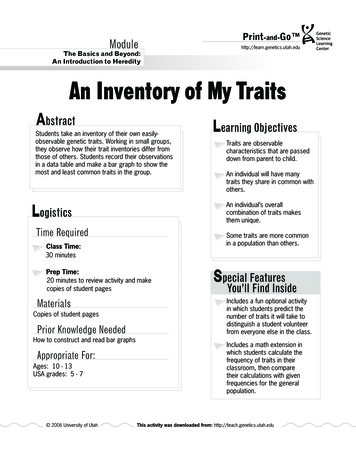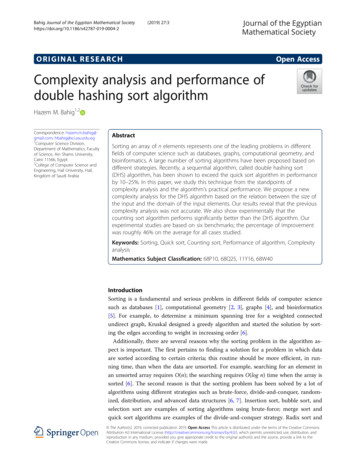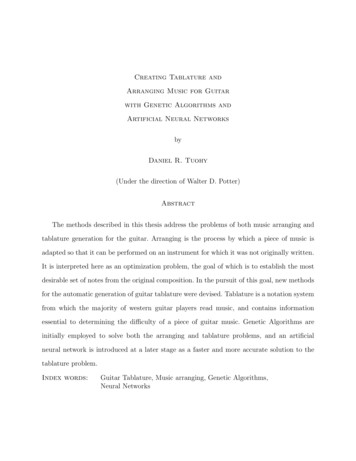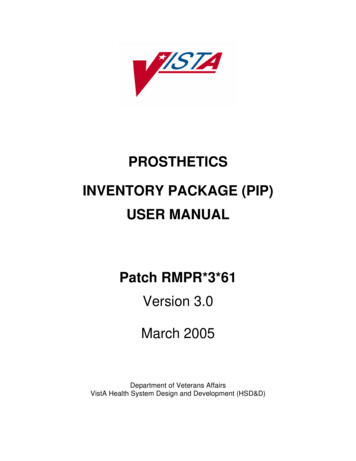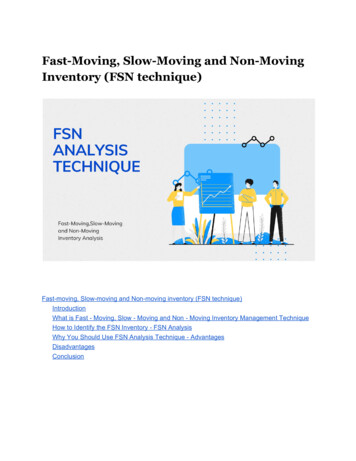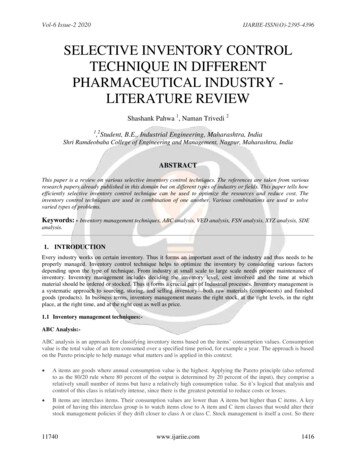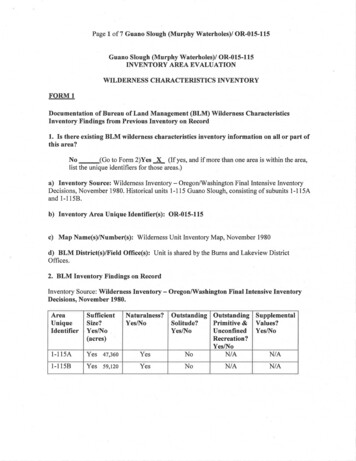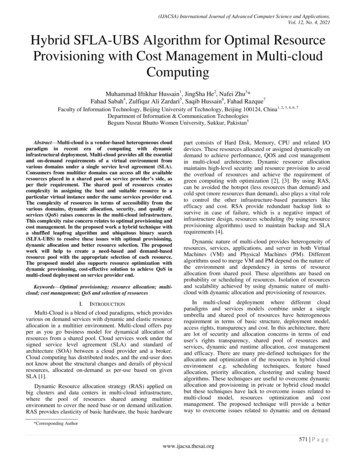
Transcription
International Journal of Engineering Research & Technology (IJERT)ISSN: 2278-0181Vol. 2 Issue 7, July - 2013Inventory Analysis Using Genetic Algorithm In Supply Chain ManagementLeena ThakurM.E. Information TechnologyThakur College of Engg & Technology,Kandivali(E)Mumbai-101,India.Aaditya A. DesaiM.E. Information TechnologyAssistant ProfessorThakur College of Engg & nufacturers, warehouses and stores to ensure properproduction and distribution of right quantities to theright location in right time and thereby reducing thetotal supply chain cost besides satisfying service levelrequirements.Inventory management is one of the significant fields insupply chain management. Efficient and effectivemanagement of inventory throughout the supply chainsignificantly improves the ultimate service provided tothe customer. Hence there is a necessity of determiningthe inventory to be held at different stages in a supplychain so that the total supply chain cost is minimized.Minimizing the total supply chain cost is meant forminimizing holding and shortage cost in the entiresupply chain. This inspiration of minimizing TotalSupply Chain Cost could be done only by optimizingthe base stock level at each member of the supply chain.The dilemma occurring here is that the excess stocklevel and shortage level is very dynamic for everyperiod. In this paper, we have developed a novel andefficient approach using Genetic Algorithm whichclearly determines the most possible excess stock leveland shortage level that is needed for inventoryoptimization in the supply chain so as to minimize thetotal supply chain cost. [2]IJERTWith the dramatic increase in the use of the Internet forsupply chain-related activities, there is a growing needfor services that can analyze current and futurepurchases possibilities as well as current and futuredemand levels and determine efficient and economicalstrategies for the procurement of direct goods. Suchsolutions must take into account the current quotesoffered by suppliers, likely future prices, projecteddemand, and storage costs in order to make effectivedecisions on when and from whom to make purchases.Based on demand trends and projections, there istypically a target inventory level that a business hopesto maintain. This level is high enough to be able to meetfluctuations in demand, yet low enough thatunnecessary storage costs are minimized. Hence thereis a necessity of determining the inventory to be held atdifferent stages in a supply chain so that the totalsupply chain cost is minimized. Minimizing the totalsupply chain cost is meant for minimizing holding andshortage cost in the entire supply chain. Thisinspiration of minimizing Total Supply Chain Costcould be done only by optimizing the base stock level ateach member of the supply chain which is verydynamic. A novel and efficient approach using GeneticAlgorithm has been developed which clearly determinesthe most possible excess stock level and shortage levelthat is needed for inventory optimization in the supplychain so as to minimize the total supply chain cost. 1. INTRODUCTIONSupply chain can be described as an integral processwherein numerous entities of diverse nature (i.e.,suppliers, manufacturers, distributors, and retailers)work in coalition so as to (1) obtain raw materials, (2)convert these raw materials into precise end products,and (3) deliver the end products to retailers .[1] Atraditional supply chain consists of the acquirement ofraw materials and production of items at one or morefactories, shipping the items to various warehouses forstorage and in turn shipping them to the respectiveretailers or customersSupply chain management can be regarded as a set ofprocedures used to proficiently combine suppliers,IJERTV2IS70550 www.ijert.org The issues in supply chain management are theshorter product lifecycles which cultivate higherdemand uncertainty and the action on globalmarkets in turn increasing the supply chaincomplexity [3,5].Supply chain can be effectively managed toreduce costs and lead times and improveresponsiveness to changing customer demandsand consequently optimizing inventory [4]Inventory management and control, production,planning and scheduling; information sharing,coordination, monitoring; and operation tools arethe four problems areas the research addressesfrom an operational perspective. [5]The total supply chain cost may be affected byhaving excess inventories and shortage ofinventories. Consequently, inventory optimizationis one of the hottest topics when the supply chainmanagement is considered [6], [7], [8].1281
International Journal of Engineering Research & Technology (IJERT)ISSN: 2278-0181Vol. 2 Issue 7, July - 2013 Inventory Optimization is designed to optimizeinventory strategies to improve customer service,reduce lead times and costs and meet marketdemand.A central concern for inventory and supply chainmanager is to find out the right amount ofinventory at each location of the supply chain,without excesses or shortages while minimizingthe total supply chain cost It is critical toaccurately estimate the optimal inventory yieldlost sales while excess of inventory may result inunnecessary storage cost.2. LITERATURE REVIEW3. INVENTORY ANALYSIS USINGGENETIC ALGORITHMIn practice, the supply chain is of length n, meanshaving n number of members in supply chain such asfactory, distribution centers, suppliers, retailers and soon. Here, for instance we are going to use a three stagesupply chain that is illustrated in the figure 1. Ourexemplary supply chain consists of a factory,distribution center 1 and distribution center 2Figure 1. Three members in Supply Chain[2]In the supply chain we are illustrated, the factory is themassive stock holding area where the stocks aremanufactured as per the requirement of the distributioncenter 1. Then the distribution center 1 will take care ofthe stock to be supplied for the distribution center 2. Asearlier discussed, the responsibility of our approach isto predict an optimum stock level by using the pastrecords and so that by using the predicted stock levelthere will be no excess amount of stocks and also thereis less means for any shortage. Hence it can be assertedthat our approach eventually gives the amount of stocklevels that needs to be held in the three members of thesupply chain, factory, distribution center l anddistribution center 2.In our proposed methodology, we are using geneticalgorithm for finding the optimal value. The flow ofoperation of our methodology is clearly illustrated infigure 2IJERTBeamon presents a study and evaluations of theperformance measures employed in supply chainmodels and have also displayed a framework for thebeneficial selection of performance measurementsystems for manufacturing supply chains. Three kindsof performance measures have been recognized asmandatory constituents in any supply chainperformance measurement system. New flexibilitymeasures have been also created for the supply chains[1]In [4] Pongcharoen et al., proposes a multi-matrix realcoded Generic Algorithm (MRGA) based optimizationtool that minimizes total costs associated with in supplychain logistics The objectives of this paper were toi)present the mathematical model for minimizing totalcosts raised from raw material ,manufacturing, holdinginventory, transportations between parties and fixedoperation costs; ii)describe a multi-matrix real-codedGenetic Algorithm that always guarantee feasiblesolutions obtained from both initialization and evolutionprocesses and iii)present the computational experimentsfor investigating genetic parameters and operators usingthree sizes of dataset.Scott et al.,[9] proposed a technique for use in supplychain management that assists the decision-makingprocess for purchases of direct goods. Based onprojections for future prices and demand, Request-for –quote (RFQ) are constructed and quotes are acceptedthat optimize the level of inventory each day, whileminimizing total cost. The problem is modeled as aMarkov decision process, which allows for thecomputation of the utility of actions to be based on theutilities of consequential future states. Dynamicprogramming is then used to determine the optimalquote requests and accepts at each state .In this paper;we propose a decision-theoretic algorithm that advisesthe buyer when and from whom to buy by looking atpossible future decisions. The buyer is advised to takean action if and only if there is no present or futurealternative that would yield greater overall expectedutility.Abdel et al.,[10] described a fresh genetic algorithm(GA) approach for the integrated inventory distributionproblem has been projected by Abdel et al. They havedeveloped a genetic representation and have utilized arandomized version of a formerly developedconstruction heuristic in order to produce the initialrandom population. In this paper, the integratedinventory distribution problem, which is classified as atime domain problem, considers multiple planningperiods, both inventory and transportation costs, and asituation in which backorders are permitted.IJERTV2IS70550www.ijert.org1282
International Journal of Engineering Research & Technology (IJERT)ISSN: 2278-0181Vol. 2 Issue 7, July - 20133.3 CrossoverA single crossover function is used. The genes that areright of the cross over point in the two chromosomesare swapped and hence the cross over operation is done.After the crossover operation two new chromosomesare obtained.Figure 3. Before CrossoverFigure 2 . Operational flow of methodology[2]IJERTInitially, the amount of stock levels that are in excessand the amount of stocks in shortage in the differentsupply chain contributors are represented by zero ornon-zero values. Zero refers that the contributor needsno inventory control while the non-zero data requiresthe inventory control. The non-zero data states both theexcess amount of stocks as well as shortage amount.The excess amount is given as positive value and theshortage amount is mentioned as negative value.The first process needs to do is the clustering thatclusters the stock levels that are either in excess or inshortage and the stock levels that are neither in excessnor in shortage separately. This is done simply byclustering the zero and non- zero values. For thispurpose we are using, the efficient K means clusteringalgorithm.After the process of K- means clustering is performed,the work starts its proceedings on Genetic algorithm,the heart of our work.Figure 4. After Crossover3.4 MutationThe newly obtained chromosomes from the crossoveroperation are then pushed for mutation. By performingthe mutation, a new chromosome will be generated.This is done by a random generation of two points andthen performing swaps between both the genes.3.1 Chromosome RepresentationFigure 5. Before MutationThe randomly generated initial chromosome is createdby having the stock levels within the lower limit and theupper limit for all the contributors of the supply chain,factory and the distribution centers. The stock level ofeach member of the chromosome is referred as gene ofthe chromosome. Hence for n length supply chain, thechromosome length is also n. As we are using onlythree members of the chain, the length of thechromosome n is 3.Initially, only two chromosomes will be generated andfrom the next generation a single random chromosomevalue will be generated3.2 Fitness FunctionFitness functions ensure that the evolution is towardoptimization by calculating the fitness value for eachindividual in the population. The fitness value evaluatesthe performance of each individual in the population.IJERTV2IS70550Figure 6. After MutationThe mutation operation provides new chromosomes thatdo not resemble the initially generated chromosomes.After obtaining the new chromosome, another randomchromosome will be generated. Then again the processrepeats for a particular number of iterations while thetwo chromosomes that are going to be subjected for theprocess is decided by the result of the fitness function.Each number of iteration will give a best chromosomewww.ijert.org1283
International Journal of Engineering Research & Technology (IJERT)ISSN: 2278-0181Vol. 2 Issue 7, July - 2013and this is will be considered to find an optimal solutionfor the inventory control. When the number ofiterations are increased then the obtained solutionmoves very closer to the accurate solution have toimprovise.4. ResultThe stock levels for the three different members of thesupply chain, factory 1,distribution center 1 anddistribution center 2 are generated using the MySQLand this generated data set used in each member ofsupply chain is used for evaluating the performance ofthe genetic algorithm.Sample data set is given in table 1.Table 1 .Sample data setFactoryDistributioncentre 1Distributioncentre 548837-295IJERTFigure 7. Admin Login ScreenThe two initial chromosomes are generated at thebeginning of the genetic algorithm are „1229 269 -456‟and „792 171 44‟. These initial chromosomes aresubjected for the genetic operators, Crossover andMutation.As for our iteration value of „100‟, theresultant chromosome moved towards the bestchromosome after the each iterative execution. Hence atthe end of the execution of 100th iteration, bestchromosome „1229 44 171‟ is obtained.Simulation result showing the fitness functionimprovementFor 10th Iteration- fitness -0.00137For 20th Iteration- fitness -0.00413For 50th Iteration- fitness -0.0096For 100th Iteration – fitness -0.011Figure 8. Main Genetic Algorithm Screen5. CONCLUSIONInventory management is one of the important fields inSupply chain management. I have presented a novelefficient approach using Genetic Algorithm whichclearly determined the most possible excess stock leveland shortage level that is needed for inventoryoptimization so as to minimize the total supply chaincost. The approach had been implemented in the JAVA,NetBeans and MySQL database to visualize itsperformance. The stock level thus obtained is theoptimal value which is sufficient and essential so thatsupply chain cost will be minimized6. REFERENCES[1] Beamon BM “Supply chain design and analysis: modelsand methods”, International Journal of ProductionEconomics, Vol: 55, No. 3, page: 281-294, 1998[2] P. Radhakrishnan, Dr. V.M. Prasad, Dr. M. R. Gopalan,“Genetic Algorithm based inventory optimizationanalysis in supply chain management”, 2009 IEEEIJERTV2IS70550www.ijert.org1284
International Journal of Engineering Research & Technology (IJERT)ISSN: 2278-0181Vol. 2 Issue 7, July - 2013International Advance Computing Conference (IACC2009) Patiala, India, 6-7 March 2009[3] Joines J.A., & Thoney, K, Kay M.G, "Supply chainmulti-objective simulation optimization", Proceedings ofthe 4th International Industrial Simulation Conference.,Palermo, pp. 125-132, 2008[4] Pongcharoen, P., Khadwilard, A. and Klakankhai, A.,"Multi-matrix real-coded Genetic Algorithm forminimizing total costs in logistics chain network",Proceedings of World Academy of Science ,Engineeringand Technology, vol. 26, pp .458-463, December 14th16th,2007[5] Ganeshan,R., Jack,E.,Magazine, M.J.,Stephens,P., "Ataxonomic review of supply chain managementresearch", Quantitative Models for Supply etts, pp. 841-879, 1999.[6] "Optimization Engine for Inventory Control", whitepaper from Golden Embryo Technologies pvt. ltd.,Maharastra, India, 2004.[7] Jinmei Liu, HuiGao, Jun Wang, "Air material inventoryoptimization model based on genetic algorithm,"Proceedings of the 3rd World Congress on IntelligentControl and Automation, vol.3, pp: 1903 - 1904,2000IJERT[8] C.M. Adams, "Inventory optimization techniques, systemvs. item level inventory analysis," 2004 AnnualSymposium RAMS - Reliability and Maintainability, pp:55 - 60, 26-29, Jan, 2004.[9] S. Buffett, N. Scott, "An Algorithm for Procurement inSupply Chain Management", AAMAS-04 Workshop onTrading Agent Design and Analysis, New York, 2004.[10] Abdelmaguid T.F, Dessouky M.M,"A genetic algorithmapproach to the integrated inventory-distributionproblem", International Journal of Production Research44, Page: 4445-4464, 200IJERTV2IS70550www.ijert.org1285
Inventory management is one of the significant fields in supply chain management. Efficient and effective management of inventory throughout the supply chain significantly improves the ultimate service provided to the customer. Hence there is a necessity of determining the inventory to be held at different stages in a supply .
